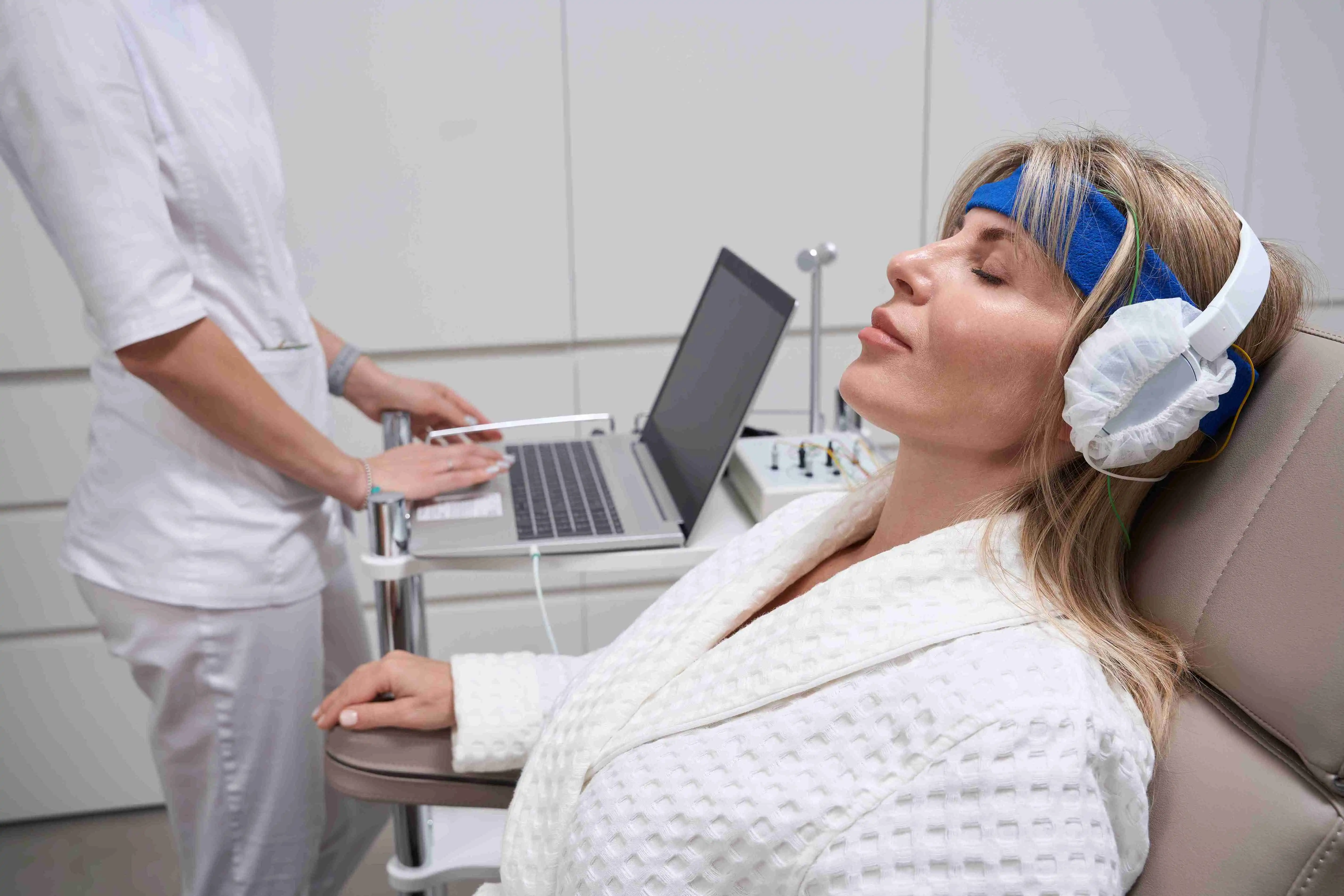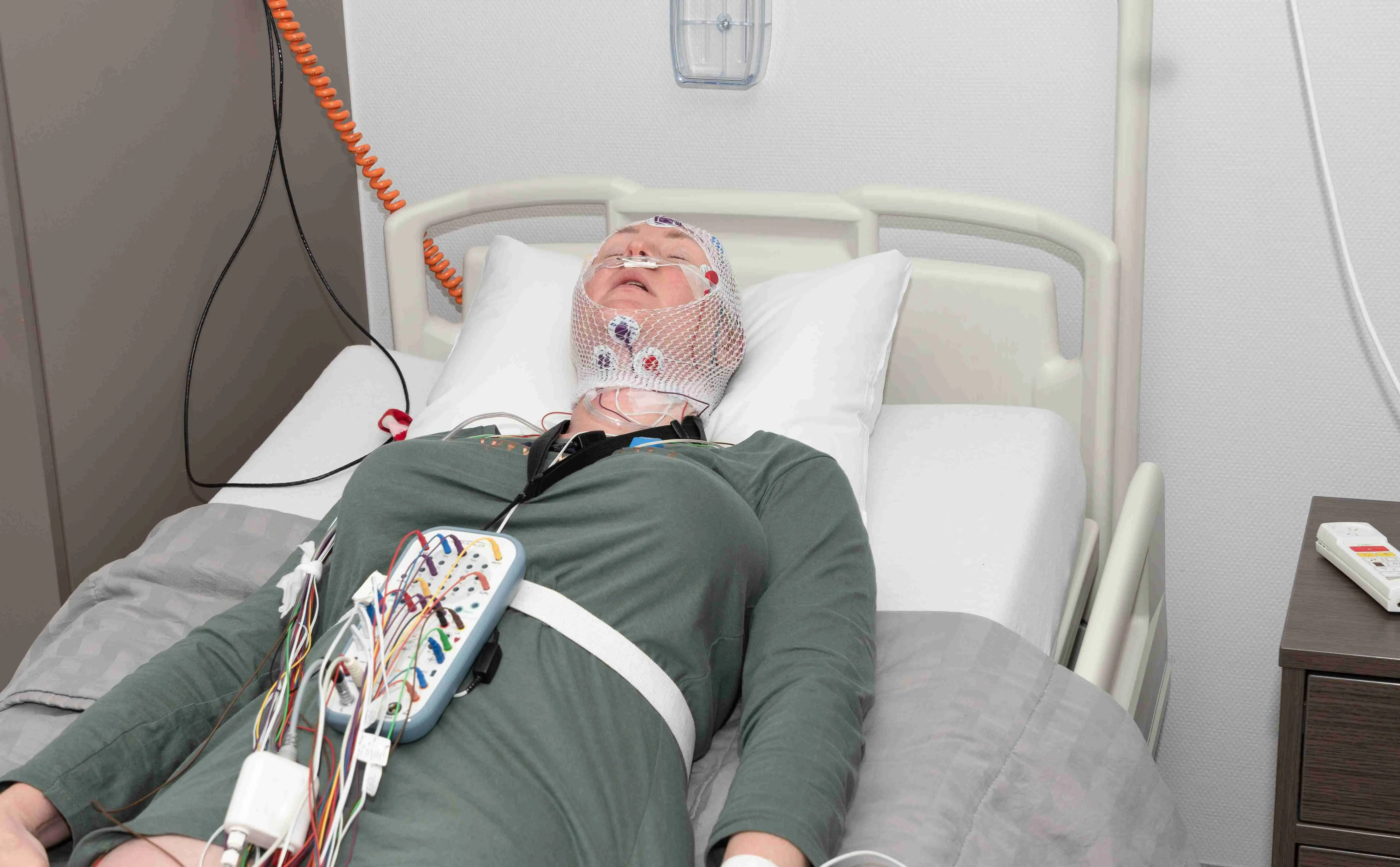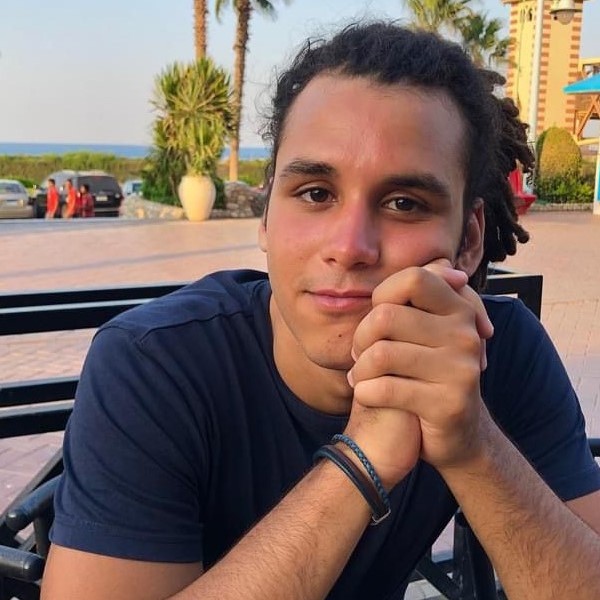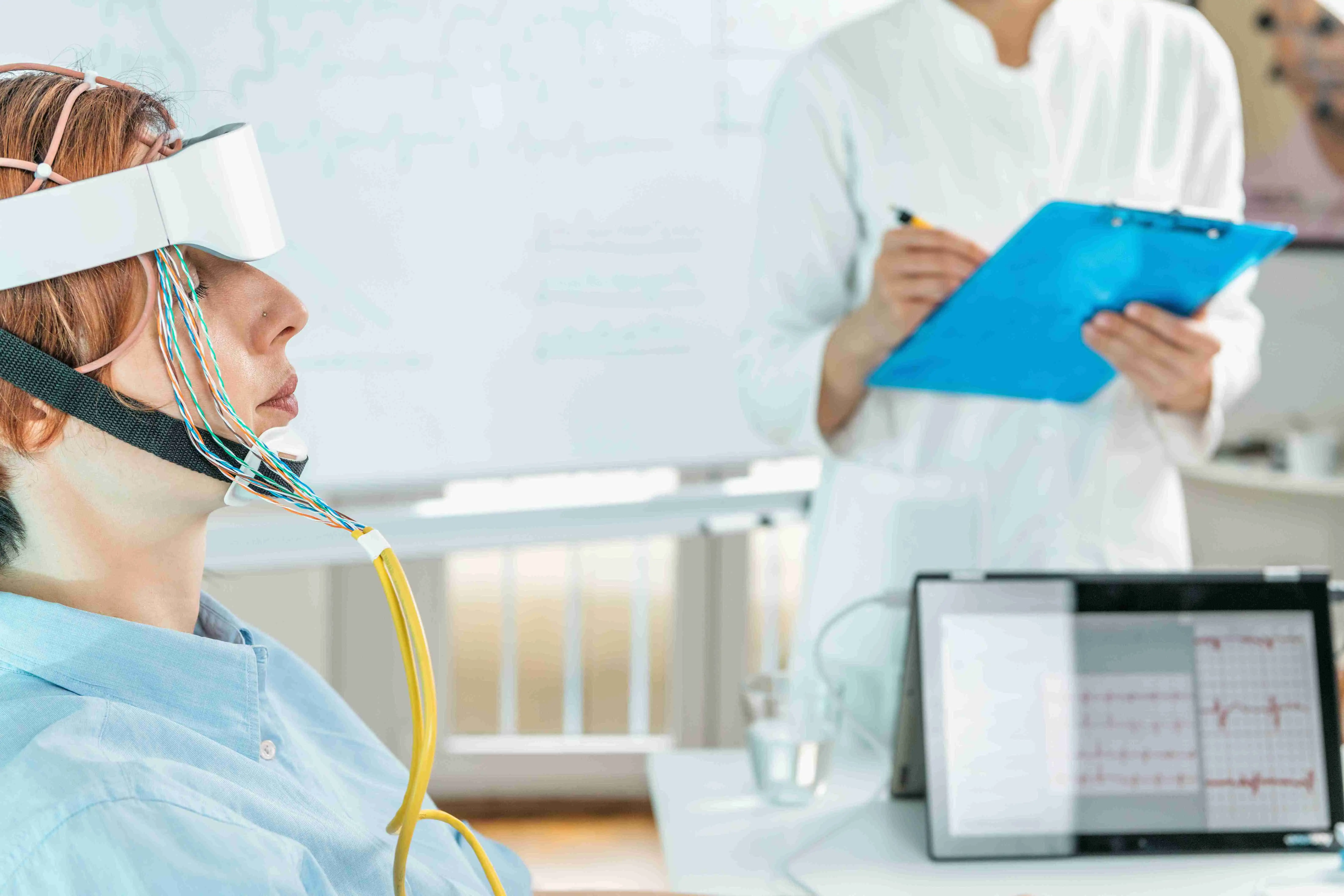Sleep plays a crucial role in our lives and is essential for our productivity, cognitive function, and overall quality of life. However, one of the biggest threats to healthy sleep patterns is conditions such as insomnia, restless leg syndrome, and sleep apnea, which can be a real issue for many people.
Fortunately, a medical test known as a sleep study or polysomnography aids in the diagnosis and treatment of these sleep disorders.
What is a sleep study?

A sleep study, also known as a polysomnography, is a medical test that monitors and records various physiological parameters during sleep. It is conducted to diagnose and evaluate sleep disorders such as sleep apnea, insomnia, narcolepsy, and restless legs syndrome.
During a sleep study, the patient is connected to electrodes and sensors that measure brain waves, eye movements, heart rate, breathing patterns, and oxygen levels.
To evaluate the quality and quantity of sleep, sleep specialists gather and analyze this data. A sleep study helps in determining the underlying causes of sleep disturbances and guides the development of appropriate treatment plans.
Types of Sleep Studies
Different types of sleep studies cater to specific needs and populations. Each type of study plays a crucial role in the diagnosis and treatment of sleep disorders, ultimately improving the quality of sleep for individuals of all ages.
Polysomnography (PSG)
Polysomnography (PSG) is a type of sleep study that measures various physiological parameters during sleep. Often used to evaluate sleep apnea, narcolepsy, and other sleep-related conditions, it is considered the gold standard for diagnosing sleep disorders.
During a PSG, electrodes are placed on the scalp, face, chest, and legs to record brain activity, eye movements, muscle tone, heart rate, and breathing patterns.
Multiple Sleep Latency Test (MSLT)
Multiple sleep latency tests measure the time it takes for an individual to fall asleep during the day. This test primarily evaluates excessive daytime sleepiness and aids in diagnosing conditions like narcolepsy.
Maintenance of Wakefulness Test (MWT)
The maintenance of wakefulness test evaluates an individual's ability to stay awake during specific periods of time.
People who work in jobs that require high levels of alertness, like pilots or truck drivers, commonly use the MWT for assessment.
Actigraphy
Actigraphy is a non-invasive technique that tracks a person's sleep-wake patterns over time.
This study involves wearing a small device on the wrist that measures movement and light exposure, providing information about sleep duration, quality, and timing.
Portable Sleep Monitoring
These studies can be conducted in a sleep laboratory or through portable sleep monitoring devices. One type of sleep study is portable sleep monitoring, which allows patients to undergo sleep studies in the comfort of their own homes.
This type of study involves the use of small, portable devices that measure different parameters, such as heart rate, oxygen level, and brain waves.
Electroencephalography (EEG) for Sleep
Sleep studies frequently use electroencephalography (EEG), a technique that measures the electrical activity of the brain.
In sleep medicine, EEG recordings are used to assess sleep stages, identify abnormal brain activity during sleep, and help diagnose conditions such as sleep-related epilepsy.
CPAP Titration
Continuous positive airway pressure (CPAP) titration studies are specifically designed to determine the optimal pressure settings for individuals who require CPAP therapy for OSA.
During this study, individuals wear a CPAP mask, and the pressure level is adjusted throughout the night to identify the most effective setting that eliminates breathing disturbances and improves sleep quality.
Home Sleep Apnea Test (HSAT)
An individual can conduct Home Sleep Apnea Testing (HSAT), a type of sleep study, in the comfort of their own home. It involves wearing a portable monitoring device that records various parameters, such as airflow, oxygen levels, and heart rate.
HSAT is a more practical and affordable alternative to in-lab PSG for diagnosing obstructive sleep apnea (OSA).
Pediatric Sleep Studies
Children are the focus of pediatric sleep studies. Children can experience various sleep disorders such as sleep apnea, insomnia, and restless leg syndrome.
Pediatric sleep studies involve the monitoring of a child's sleep patterns, breathing, brain waves, and movements during sleep.
Conditions That a Sleep Study Can Diagnose
A sleep study is an essential tool for diagnosing various sleep disorders. By monitoring different aspects of an individual's sleep patterns and behaviors.
sleep specialists can accurately diagnose these conditions and develop appropriate treatment plans to improve their patient's overall quality of life.
Insomnia
Insomnia is characterized by difficulty falling asleep or staying asleep, leading to poor quality sleep. A sleep study monitors the patient's brain activity, eye movements, heart rate, and breathing patterns to evaluate the quality and duration of their sleep.
Sleep specialists can determine whether the patient's insomnia is due to underlying medical conditions or behavioral factors by analyzing these parameters.
Sleep Apnea
Sleep apnea is a disorder in which a person's breathing repeatedly stops and starts during sleep. This can occur due to a blockage in the airway or a problem with the brain's signaling to the muscles that control breathing.
A sleep study can help identify the presence and severity of sleep apnea by monitoring the patient's breathing patterns, oxygen levels, and body movements during sleep.
Restless Leg Syndrome
Restless Legs Syndrome (RLS) is a neurological disorder that causes uncomfortable sensations in the legs, often described as itching, tingling, or creeping.
These sensations typically worsen at night and can disrupt sleep. A sleep study can help diagnose RLS by monitoring the patient's leg movements during sleep and assessing their impact on sleep quality.
Identifying RLS through a sleep study is important because it can lead to effective treatment options such as medications or lifestyle changes that can alleviate symptoms and improve sleep.
Narcolepsy
Narcolepsy, also known as sleepwalking, involves getting out of bed and walking around while still asleep. We observe and record the patient's nocturnal behaviors during a sleep study to determine if they are experiencing episodes of sleepwalking.
Identifying sleepwalking through a sleep study is crucial in understanding the frequency and severity of the episodes, as well as any potential underlying causes or triggers.
Periodic Limb Movement Disorder
Periodic limb movement disorder (PLMD) is a condition characterized by repetitive movements of the limbs during sleep, such as jerking or kicking. These movements can disrupt sleep and lead to daytime fatigue and other negative consequences.
A sleep study is instrumental in diagnosing PLMD by monitoring leg movements throughout the night. The study also monitors other physiological parameters like heart rate and oxygen levels to rule out other potential causes, in addition to tracking the frequency and intensity of limb movements.
Sleepwalking
Sleepwalking involves getting out of bed and walking around while still asleep. We observe and record the patient's nocturnal behaviors during a sleep study to determine if they are experiencing episodes of sleepwalking.
Identifying sleepwalking through a sleep study is crucial in understanding the frequency and severity of the episodes, as well as any potential underlying causes or triggers.
Sleep Talking
Sleep talking, or somniloquy, is a sleep disorder characterized by talking during sleep without the person being aware of it. A sleep study can help diagnose this condition by recording audio during the night to capture any verbalizations.
By analyzing the recordings, sleep specialists can determine the frequency and intensity of sleep-talking episodes, as well as any underlying causes or triggers.
REM Sleep Behavior Disorder
A sleep study can also diagnose REM sleep behavior disorder (RBD). RBD is characterized by individuals acting out their dreams during REM sleep, which is one of sleep stages, typically through movements such as kicking, punching, or screaming.
A sleep study monitors muscle activity and brain wave patterns to identify any abnormal behaviors during REM sleep.
By observing these behaviors, sleep specialists can diagnose RBD and recommend appropriate treatments such as medication or lifestyle modifications to manage the disorder.
Nocturnal Panic Attacks
Nocturnal panic attacks are characterized by sudden and intense feelings of fear or terror during sleep, leading to abrupt awakenings. Physical symptoms such as rapid heart rate, sweating, and shortness of breath can accompany these episodes.
By monitoring brain activity, heart rate, oxygen levels, and other physiological parameters during sleep, a sleep study can provide valuable insights into the occurrence and severity of these nocturnal panic attacks.
Certain Types of Seizures and Epilepsy
One of the conditions that a sleep study can diagnose is certain types of seizures and epilepsy. During the study, electrodes are placed on the patient's scalp to monitor brain activity.
This allows healthcare professionals to detect abnormal electrical patterns that may indicate seizures or epilepsy.
Additionally, the study also measures other parameters such as muscle activity, eye movements, and breathing patterns, which can provide further insights into the presence of these conditions.
Preparing for a Sleep Study

To achieve optimal results and maximize the benefits of a sleep study, it's crucial to adhere to a few pre-test instructions and ensure the availability of certain items.
Pre-Test Instructions
- Maintain Your Regular Sleep Schedule: Maintaining your regular sleep schedule is crucial when preparing for a sleep study. The purpose of a sleep study is to monitor your sleep patterns and identify any underlying sleep disorders or issues. We recommend sticking to your usual sleep routine in the days leading up to the test to ensure accurate results.
- Avoid Caffeine and Alcohol: Caffeine is a stimulant that can interfere with sleep patterns and make it difficult to fall asleep during the study. Similarly, alcohol can disrupt the normal sleep cycle and affect the quality of sleep. By avoiding these substances, the sleep study can accurately capture the individual's natural sleep patterns and provide more reliable data for analysis.
- Check With Your Doctor About Medications: Certain medications can affect the outcome of a sleep study, so it is crucial to inform your doctor about them beforehand. They may advise you to temporarily stop taking certain medications or adjust their dosage leading up to the test. This will prevent any medication interactions from influencing the sleep study results and ensure an accurate assessment of your sleep patterns.
- Avoid Using Hair Products: The sensors and electrodes placed on the scalp during the study may interfere with hair products like gels, sprays, and oils. These products can create a barrier between the scalp and the electrodes, reducing the effectiveness of the test. We recommend thoroughly washing the hair before the study and refraining from using any hair products until after the completion of the study.
- Inform your Healthcare Provider of Any Allergy you Have: This is essential because certain materials and substances used during the sleep study may trigger an allergic reaction. By informing your healthcare provider, they can take the necessary precautions and provide alternative options if needed. It's important to prioritize your safety and comfort during the sleep study, and providing information about any allergies is a crucial part of that process.
What to Bring
- Pack Comfortable Sleepwear: Choose sleepwear made from breathable and lightweight fabrics that allow your body to regulate its temperature. Avoid tight or restrictive clothing that could affect your sleep quality. Additionally, consider bringing an extra set of sleepwear in case of any accidents or spills during the night.
- Bring Personal Care Items: This includes items such as toothbrushes, toothpaste, and any other oral hygiene products that you typically use before bed. It is also a good idea to bring any necessary skincare products, such as moisturizer or face wash, as part of your nighttime routine. These personal care items will help you maintain your regular hygiene practices even during the sleep study.
- Check With the Sleep Lab About Bringing Your Pillow or Blanket: Before bringing your pillow, it is essential to check with the sleep lab about their policy regarding personal bedding. Some labs may have specific guidelines or restrictions in place for hygiene purposes. It is important to follow these guidelines to maintain a clean and controlled testing environment. Therefore, we recommend contacting the lab beforehand to inquire about their policies and whether you can bring your pillow.
- Entertainment: Since a sleep study typically involves spending the night in a sleep center, having something to keep yourself entertained can help pass the time and make the experience more enjoyable. This could be a book, a tablet or laptop with movies or TV shows, or even a favorite board game or puzzle.
What to Expect During a Sleep Study
While the sleep study monitors your sleep patterns, it does not replicate a typical night's sleep. Most people adapt to the presence of the sensors and electrodes and manage to get some sleep during the study.
The goal of the sleep study is to collect accurate data that can help diagnose any potential sleep disorders or issues that may be affecting your quality of sleep.
Arrival and Setup
This involves checking in at the sleep center or hospital and filling out any necessary paperwork. The staff will then show you to your comfortable and sleep-friendly room.
In some cases, you may have a private room, while in others, you may share with another patient. Once you are settled in, a technician will come in to attach various sensors and electrodes to your body.
These sensors are painless and non-invasive, and they are used to monitor your brain waves, heart rate, breathing patterns, and other important data during the sleep study.
Overnight Monitoring
Once the setup is complete, you will begin the overnight monitoring phase of the sleep study. This is when the sensors and electrodes will be connected to monitoring equipment that is located outside of your room.
During the night, the equipment will record and measure various aspects of your sleep, such as your brain activity, eye movements, muscle tone, and breathing patterns.
The technician will be monitoring the data throughout the night from a separate room, ensuring that everything is running smoothly. They will also be available to assist you if you need anything during the study.
Understanding Sleep Study Results
Understanding the results of a sleep study is crucial for developing an appropriate treatment plan. Based on the findings, the sleep specialist will recommend suitable interventions to address the specific sleep disorder.
These interventions may include lifestyle changes, medication, breathing devices, or therapies to improve sleep quality.
Interpreting the Data
Interpreting the data from these studies involves analyzing various measurements and observations recorded during the study, such as brain activity, heart rate, eye movements, and oxygen levels.
This data provides valuable insights into the quality and quantity of a person's sleep, as well as any potential sleep disorders they may have.
Follow-Up Consultation
During a follow-up consultation with a sleep specialist or physician, the results of the sleep study are discussed in detail. The specialist will explain the findings, including any abnormal patterns or indications of sleep disorders.
It is important to note that not all abnormalities detected in a sleep study necessarily indicate a sleep disorder.
Risks and Side Effects of a Sleep Study
While a sleep study is generally considered safe and well-tolerated, there are some risks and potential side effects associated with this procedure.
It is important for healthcare professionals to be aware of these potential side effects and take appropriate measures to minimize their impact on the patient's experience and the quality of the sleep study results.
The Discomfort Associated with the Sensors and Electrodes Attached
One of the main concerns is the discomfort associated with the sensors attached to the skin. These sensors are used to monitor brain activity, eye movement, muscle tension, and other parameters during sleep.
The adhesives used to attach these sensors may cause skin irritation or allergic reactions in some individuals. Therefore, patients need to inform the sleep technologist about any known allergies or sensitivities to adhesive materials before the study begins.
Skin Irritation
The electrodes used to monitor brain waves, eye movements, and other bodily functions during the sleep study may cause redness, itching, or irritation on the skin where they are attached.
This can be uncomfortable for the patient but is usually temporary and can be easily managed with over-the-counter creams or lotions. In rare cases, an allergic reaction to the adhesive used to attach the electrodes may occur.
Allergic Reaction
An allergic reaction to the adhesive used to attach the electrodes may occur. It is important for patients to inform the sleep technologist or healthcare professional performing the study if they have any known allergies to adhesives or other materials.
Sleep Disruption
The unfamiliar environment of a sleep laboratory, along with the presence of wires and sensors attached to the body, can make it difficult for some patients to fall asleep or stay asleep throughout the night.
This can lead to fragmented or atypical sleep patterns, which may affect the accuracy of the results obtained from the study.
Additionally, skin irritation or allergic reactions can cause discomfort that makes it harder to sleep. It is essential for healthcare professionals to take these factors into account when interpreting the results of a sleep study.
Residual Drowsiness
One common side effect is residual drowsiness, which occurs after the study has been completed. This drowsiness can linger for several hours, affecting the individual's ability to drive or operate machinery safely.
FAQs
Who Needs a Sleep Study?
It is typically recommended for individuals who are experiencing symptoms such as excessive daytime sleepiness, snoring, or difficulty falling or staying asleep. One group of people who may benefit from a sleep study is those who suffer from residual drowsiness despite getting an adequate amount of sleep.
Does someone watch you during a sleep study?
During a sleep study, it is common for someone to monitor you. Sleep studies are conducted to diagnose sleep disorders such as sleep apnea or insomnia. In order to accurately observe your sleep patterns and collect data, a trained technician will be present throughout the study.
Is sleep study painful?
The procedure is painless and does not cause any discomfort to the patient. Electrodes are placed on the scalp, face, chest, and legs to record the necessary data. Although it may take some time to get used to sleeping with the electrodes attached, most people find the process relatively comfortable.
How long does a sleep study take?
The duration of a sleep study can vary depending on the individual and the type of study being conducted. Typically, an overnight sleep study lasts between 6 and 8 hours.
What should I expect after a sleep study?
After a sleep study, you can expect to receive a comprehensive report that provides detailed information on your sleep patterns, including the number and duration of different sleep stages, any disruptions or abnormalities observed, and any potential sleep disorders that may have been identified.
What if I can't sleep during a sleep study?
If you find yourself unable to sleep during a sleep study, it is important to remain calm and patient. The technicians conducting the study are trained professionals who understand that sleep can be elusive in an unfamiliar environment. They will work with you to create a comfortable and relaxing environment, offering suggestions to help you relax and fall asleep.
Who performs a sleep study?
A healthcare professional known as a sleep technologist or polysomnographic technologist conducts a sleep study. These professionals are highly trained in conducting sleep studies and analyzing the data collected during the study.
Conclusion
By monitoring brain activity, eye movements, and other physiological parameters during sleep, polysomnography helps identify abnormalities such as sleep apnea, insomnia, and narcolepsy.
The data collected during a sleep study is crucial in determining the appropriate treatment plan for patients. It allows healthcare providers to make informed decisions and provide personalized care to individuals suffering from sleep disorders.
In summary, polysomnography plays a significant role in diagnosing and managing sleep-related conditions, ultimately improving the quality of life for affected individuals.
Dom Abraham
As the lead content writer at Sleepiverse. Dom pours his heart into writing mattress reviews, bedding product reviews, and medically-reviewed health articles. Dom is from Portugal and likes to spend his free time writing on the beach as it gives him a sense of comfort. Aside from writing mattress reviews in front of the soothing beach view, Dom likes to experiment with new amazing food ideas.


